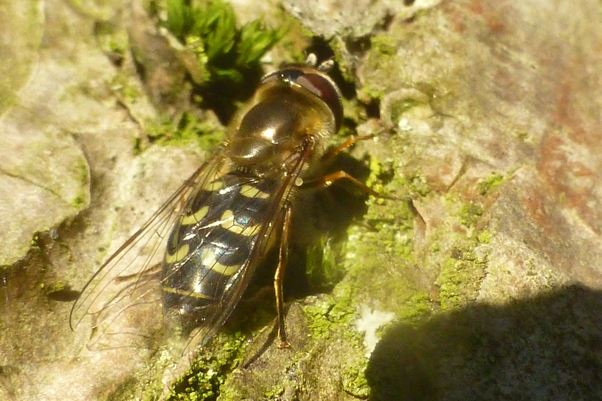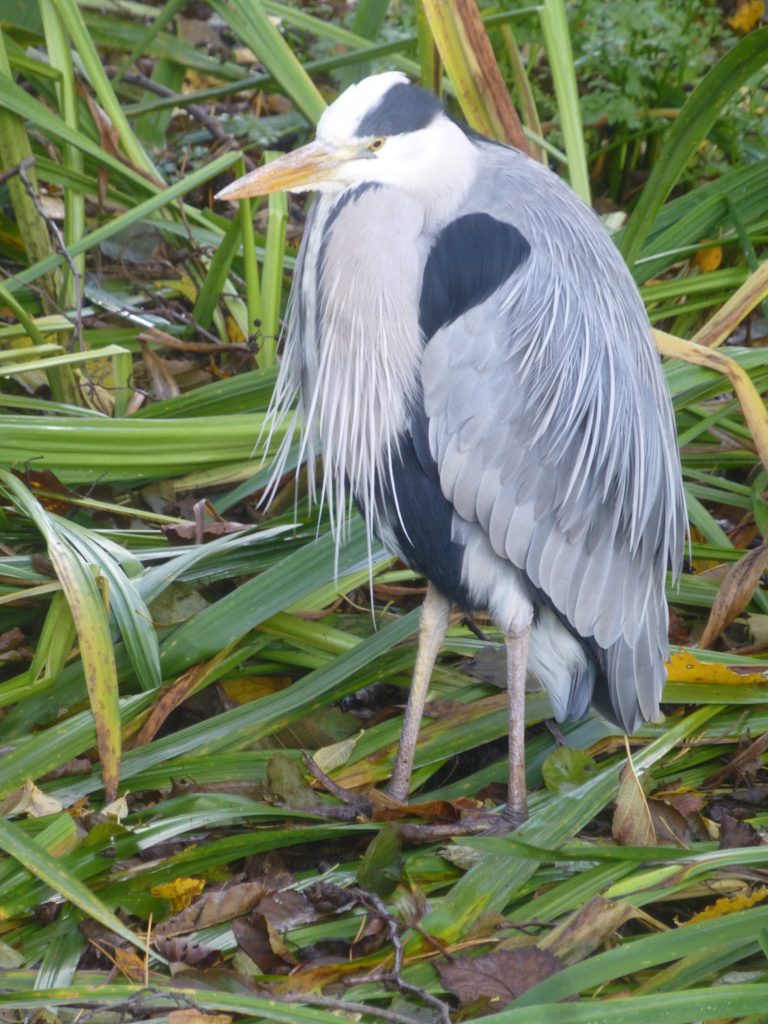
Grey Squirrel (Sciurus caroliniensis) performing acrobatics to drink from the pond at Inverleith House, 20 November 2017. Photo Jane Robertson.
November 2017 was a real ‘autumn’ month, with lovely golden colours and plenty of frosty mornings as well as a few really wet days. Four new additions to the Garden’s wildlife list were made, raising it from 931 to 935: three bugs and one spider.
Mammals and amphibians: Once again there were single records of House Mouse and Fox, both on 12th, as well as daily evidence of Badgers’ nocturnal hunting for grubs. Amphibians were presumably hibernating as none were seen. Grey Squirrels were active all month and one was seen doing acrobatics to get a drink from the pond in front of Inverleith House (see photo above).
Birds November 2017 was an exceptionally rewarding month for bird recording at RBGE Edinburgh! No fewer than 48 species were recorded during the month, two more than the previous highest monthly total of 46 nearly seven years ago in January 2011. Britain, particularly southern England, has been seeing a massive influx of the normally very scarce Hawfinch since October; some of these reached the Edinburgh area in November, with a record from the Botanics (by a visitor) during the second week of the month. Hawfinches used to breed in the Botanics, but the last resident birds left in the 1980s. Other highlights included a Dipper at the Biodiversity pond on 23rd, a ‘redhead’ (i.e. female or juvenile) Goosander on the main Pond (28th), Kingfisher there practically every day, Nuthatch recorded twice (1st and 13th), two hen Pheasant on 10th and 13th, and a Woodcock flushed in the Woodland Garden on 6th. The complete list of 48 species recorded during November 2017 was: Blackbird, Blackcap, Black-headed Gull, Blue Tit, Bullfinch, Buzzard, Carrion Crow, Chaffinch, Coal Tit, Curlew, Dipper, Dunnock, Feral Pigeon, Goldcrest, Goldfinch, Goosander, Great Spotted Woodpecker, Great Tit, Greenfinch, Grey Heron, Grey Wagtail, Hawfinch, Herring Gull, Jackdaw, Kingfisher, Long-tailed Tit, Magpie, Mallard, Mistle Thrush, Moorhen, Mute Swan, Nuthatch, Oystercatcher, Pheasant, Pied Wagtail, Pink-footed Goose, Redwing, Robin, Rook, Siskin, Song Thrush, Sparrowhawk, Stock Dove, Tawny Owl, Tree Creeper, Woodcock, Wood Pigeon, Wren.

Black Bean Aphids (winged adults, unwinged nymphs , and eggs) on Euonymus, 8 November 2017. New Garden record. Photo Robert Mill.

Bow-legged Spruce Aphid (Cerina curvipes), on Abies, 14 November 2017. New Garden record. Photo Robert Mill.
Insects and other invertebrates: November 2017’s only butterfly sighting was of a Red Admiral on 2nd. Moth trapping was almost as unrewarding, with a single Spruce Carpet on 3rd, a single Silver Y on 10th, and nothing at all on 17th; trapping was not possible on 24th because of technical problems connected with the power supply, and also a hard overnight frost. The near absence of trapped moths was somewhat compensated by the 15 species of leaf-mining moths that were identified from their mines; none were new records, but five were spotted for the first time in 2017. Buff-tailed Bumblebee (14th) and Common Wasps (3rd, 9th, 12th) were the only aculeates seen in November. Hoverflies were also very scarce; Marmalade Hoverfly, Banded Hoverfly and Yellow-clubbed Scaeva Scaeva selenitica were all found basking on tree trunks on 16th, and a second Banded Hoverfly was seen on 2nd. November’s only other fly records included the bluebottle Calliphora vicina on 16th and 30th, Winter Gnats from 14th onwards, and a flesh fly (Sarcophaga aff. carnaria) on 16th. Among the bugs, the flower bug Anthocoris nemoralis (1st and 21st), Black Bean Aphid (Aphis fabae) on 8th, and Bow-legged Spruce Aphid (Cerina curvipes) on 14th were all new Garden records, while Hawthorn Shield Bug was seen on both 1st and 8th, and a Forest (Red-legged) Shield Bug on 1st. No beetles, barkflies or springtails were recorded in November. The harvestman Oligolophus hanseni was on a tree-trunk on 23rd, while a Rabbit Hutch Spider (Steatoda bipunctata) found inside the Herbarium basement was November’s fourth new Garden record. A few galls made by three gall-mites remained on those leaves that had not been shed. Finally, a Common Rough Woodlouse was climbing up the rear entrance to the Herbarium building on 21st, no doubt enjoying the heavy rain that day.

Yellow-clubbed Scaeva hoverfly Scaeva selenitica basking on pine trunk, 16 November 2017. Photo Robert Mill.

